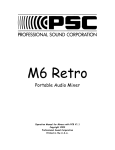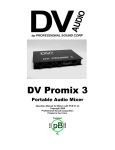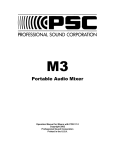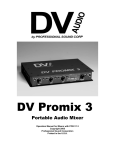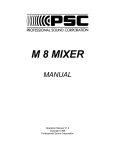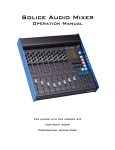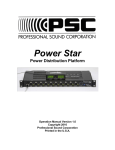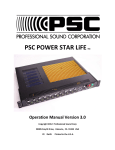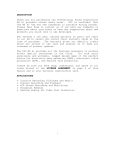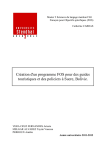Download Professional Sound Corporation MJR Specifications
Transcript
PROFESSIONAL SOUND CORPORATION MJR Portable Audio Mixer Operation Manual for Mixers with PCB V1.2 Copyright 1999, 2000, 2001, 2002 Professional Sound Corporation Printed in the U.S.A. TABLE OF CONTENTS DESCRIPTION……………………………………………………………………………4 SAFETY WARNINGS……………………………………………………………………4 APPLICATIONS…………………………………………………………………………..4 FUNCTIONS INPUTS……………………………………………………………………………..5 A. BALANCED INPUTS B. INPUT LEVELS C. MICROPHONE POWERING D. LOW CUT FILTER E. CHANNEL GAIN F. CHANNEL PANS OUTPUTS…………………………………………………………………………...6 MONITOR……………………………………………………………………………6 TAPE RETURNS……………………………………………………………………6 METERS……………………………………………………………………………...7 ADDITIONAL FEATURES………………………………………………………….8 A. SLATE MICROPHONE B. REFERENCE OSCILATOR 2 POWERING…………………………………………………………………………..8 A. INTERNAL POWER CONSTRUCTION…………………………………………………………………….9 A. CHASSIS B. ELECTRONIC TOPOLOGY C. ENVIRONMENTAL OPERATION INTERFACING………………………………………………………………………10 A. TO BETACAMS B. TO RDAT RECORDERS C. TO WIRELESS MICROPHONES D. SPECIAL NOTES WARRANTY AND NON-WARRANTY SERVICE…………………………………11 SPECIFICATIONS…………………………………………………………………….12 3 DESCRIPTION Thank you for purchasing the Professional Sound Corporation Mjr Portable Audio Mixer. PSC is confident that this new Mjr Mixer has set new standards for portable mixer technologies and features. Please feel free to contact us if you have any comments or questions concerning your new mixer. Additionally, we invite you to share your suggestions for new products you would like to see developed. Professional Sound Corporation extends a one-year warranty on parts and labor to all Mjr Mixer owners who return their warranty cards at the time of purchase. This warranty gives you specific rights, which are stated on the card, and enables us to keep you informed of product updates. The PSC Mjr Mixer provides all the functions necessary to produce studio quality recordings in the field. It’s user friendly features, rugged design and sonic purity make the Mjr Mixer perfect for electronic news gathering (ENG) electronic field production (EFP) and feature film production. HEARING SAFETY WARNINGS: Please be sure that you have read this entire manual before operating this mixer. While special attention has been given to your safety and hearing protection, the operator determines proper and safe operating levels. Please note the following: Always turn down the headphone volume before plugging in your headphones. Always operate your headphones at the lowest practical level. Be especially cautious in unknown or widely varying environments. Remember, your ears are your livelihood. Turn it down! APPLICATIONS • • • • Electronic News Gathering Location recording (Dialogue and Music) Digital Recording and Playback Broadcast remotes 4 INPUTS: A. BALANCED INPUTS The PSC Mjr Audio Mixer provides two input channels utilizing female XLR connectors. The professional grade input circuitry is transformer balanced for improved RF rejection and in-field practicality. The XLR connectors are wired as follows: Pin 1 shield (ground), Pin 2 Audio high (in phase), Pin 3 Audio low (out of phase). Balanced wiring enables longer cable runs without the worry of excessive noise due to nearby electromagnetic and radio frequency interference. These balanced inputs may be unbalanced if desired. Either pin 2 or 3 may be tied to ground (pin 1) to unbalance the inputs of the Mjr Mixer. Note: The AES standard for unbalancing an XLR connector is to tie pin 3 to ground (pin 1). B. INPUT LEVELS The PSC Mjr Mixer can accommodate a wide range in input levels. Microphone levels of all types can be handled as well as line level signals. The input range of the Mjr Mixer is –60dBu to +4dBu. Thus the Mjr is compatible with all forms of consumer and professional audio equipment. The input level switches are located below and to the right of each input XLR connector. These input level switches provide for two level settings: “M” Microphone (0dB attenuation), and “L” Line Level (50dB attenuation) These input level attenuation settings are used to correctly interface sources of varying levels to the M4mkII’s preamplifiers. Correct level matching ensures maximum headroom and lowest possible noise floor. C. MICROPHONE POWERING The Mjr Mixer can accommodate the most popular microphones used today. The microphone powering switches are located directly below the input XLR connectors. They can be switched to either Dynamic (D) or 48Phantom (48). In the Dynamic position the mixer provides no microphone powering. This position is used with Dynamic Microphones, Line Level inputs and when using Wireless Receivers. In the 48 Phantom Position the mixer provides 48 volts DC to power 48PH microphones or simplex powered microphones with a range of 9 to 52 volts or 12 to 52 volts. Pin 1 is shielded to ground while pins 2 and 3 carry 48 volts DC. The term “phantom” is derived from the fact that there is no voltage potential developed across a dynamic microphone transducer that would interfere with its operation. However, most portable wireless receivers will not operate with 48PH turned on. We strongly recommend setting inputs to dynamic for use with all wireless systems. 5 In the interest of keeping the Mjr Mixer design simple and up to date with today’s technology, we have not offered “12T” or “AB” microphone powering. Although some “12T” microphones are still in existence, all new microphone designs are 48PH. D. LOW CUT FILTERS Each input channel of the Mjr Mixer is equipped with a HP (high pass) filter. These filters are activated via the switches located below the adjacent channel fader knobs. These filters will attenuate all frequencies below 80Hz at a rate of 6dB per octave. High Pass filtering is important in location recording where wind noise can cause pre-amplifier overload. This effect can be minimized by switching in the High Pass filter. E. CHANNEL GAIN In order to limit noise and increase headroom, the channel fader controls are located in the feedback path of the pre-amplifiers. This provides continuously variable gain rather than just a decrease in channel output level when an overload situation occurs. This results in increased headroom and lower chance of signal clipping (severe distortion). F. CHANNEL PANS The new Mjr. Audio Mixer contains front panel mounted pan switches. These pan switches are used to route the individual input channel’s signal to either the left or right summing buss. These switches also have center position that allows audio to be fed to both left and right summing amps. OUTPUTS: A. BALANCED OUTPUT AMPLIFIERS The Mjr Mixer contains high quality, electronically balanced output circuitry. These outputs are switchable between line or microphone levels. At the line level setting, the mixer outputs deliver a nominal 0dBv signal into 10K Ohm loads. When set to microphone level, the outputs supply –45dBv signal levels. Please note that 10K Ohm loads are typical of the loads imposed on the mixer by most Betacams, and other recording devices. Additionally, the Mjr Mixer’s outputs are capable of driving 600 Ohm loads. 6 B. MULTI-PIN (BETACAM) CONNECTOR The Mjr Mixer is equipped with a multi-pin in/out connector designed primarily to interface with Betacams. This connector provides the left and right balanced outputs as well as left and right tape returns used for confidence monitoring. This multi-pin connection provides a convenient means of interfacing to Betacams with only one connection. In addition, this connection is located on the back side of the mixer. By locating the connector on the rear of the mixer, all your cables can be conveniently routed from the rear side of the mixer providing a clean and compact setup for use on the run. C. TRANSCRIPTION OUTPUTS The Mjr Mixer also contains a dedicated microphone level output used to feed transcription recorders. This connector is located directly below the main XLR outputs. It is a 3.5mm Stereo connector wired as follows: Tip = Left, Ring is Right, Sleeve = Ground. This connector provides a –45dBv signal. This is compatible with most transcription cassette recorders. Additionally this connector can be used to feed audio to consumer and “prosumer” camcorders. D. HEADPHONE OUTPUT The Headphone output is located on the rear panel of the mixer. The Mjr Mixer’s headphone amplifier circuitry is designed to drive virtually any headphone with an impedance rating of 32 to 600 Ohms. The headphone volume is controlled by the use of a rear panel mounted volume control. *SAFETY NOTE* ALWAYS TURN DOWN THE HEADPHONE VOLUME BEFORE PLUGGING IN YOUR HEADPHONES. E. TAPE RETURN The Mjr Mixer is equipped with tape returns used to monitor tape confidence heads from most any recording device. These tape monitor amplifiers can be adjusted to match the signal levels of most any device. These levels are adjusted using a small jewelers screwdriver (or “Greenie” screwdriver). The adjustment points are located on the right hand side of the mixer. The tape/direct switch is located on the lower right hand corner of the front panel. When set to ”D” (Direct) the phone amplifiers to monitor the mixers output signal. If switched to “T” (Tape), then the phone amplifies monitor the external source such as the Betacam. METERS: A. PEAK READING METERS The Mjr Mixer is equipped with custom made LED meters. We designed these meters to be easy to read in a variety of light conditions. These meters are peak reading to allow easy correlation to most modern camera meters. I.E. “0” on the mixer, equals “0” on the camera. In addition, the LED’s are arranged in a 7 progression of colors from green to yellow to red thus you can easily identify levels at a quick glance. ADDITIONAL FEATURES: A. SLATE MICROPHONE The Mjr Mixer is equipped with a slate microphone. This microphone is activated when the front panel “slate” momentary push button switch is pressed. The slate microphone allows the operator to put voice slates (notes) on tape for later reference. These are normally notes for editing tape. A level adjustment trim pot is located on the bottom panel of the Mjr Mixer. Turning the adjustment clockwise will increase the slate microphone level. Turning the adjustment counter-clockwise will lower the level. B. REFERENCE OSCILLATOR The Mjr Mixer is equipped with a reference oscillator used for setting of levels between the mixer and recorder. This known reference level is also used when transferring tape during editing. The Mjr’s oscillator operates at 440Hz at “0” on the meters. When setting up typical Betacams with LCD bar graph meters you simply adjust the Betacams inputs until “0” is reached. From that point on, you can monitor levels from the mixer only. We have chosen 440Hz simply because it is much more pleasant in your headphones than the typical 1Khz used by other manufactures. We have used 440 Hz on our mixers for many years. The reference oscillator is equipped with a level adjustment trim pot located inside mixer. This adjustment is factory calibrated and should not be adjusted without proper measurement equipment. C. BATTERY MONITORING The Mjr Mixer is equipped with a two LED battery indicator located on the front panel of the mixer. When the mixer is turned on, the green LED will light when the battery is in good condition. When the battery needs to be replaced, the Green LED will switch off and the Red LED will switch on alerting the operator to replace the battery at his or her earliest convenience. POWERING: A. BATTERY POWER The PSC Mjr Mixer is the first compact ENG mixer with 48 Phantom power to offer the ability to be powered from a single 9V alkaline battery. This feature provides a convenient way of powering the mixer without added size or weight. Only high quality, fresh alkaline 9V batteries should be used to power the Mjr mixer. 8 The Mjr Mixer consumes approximately 50-60mA of current when no microphones are being powered. This translates into a battery life of 5 to 10 hours. To remove the battery simply push down on the battery door and pull out the battery. Note: Never store your Mjr Mixer for extended periods of time with a battery installed in the mixer. There is a possibility that the battery may leak causing corrosion of the mixer. Battery leakage and the resulting corrosion damage is not covered under the Mjr Mixer warranty. CONSTRUCTION A. CHASSIS The new Mjr Mixer chassis has been designed for harsh field use. The complete chassis is formed from 0.070” aircraft aluminum. All punching is done on a computer controlled “Strippet” rotary turret punch press for extreme accuracy. In addition, through careful design, we have managed to keep the overall weight of the Mjr Mixer to 1.5 lbs. (0.7Kg) total. The mixers sheet metal is hand-formed using various press brake setups before the stainless steel threaded inserts are pressed permanently into place. The housing parts are then Chem Film TM plated for superior corrosion resistance before being electro-statically coated with an epoxy powder coating. This powder coat paint is then baked on. Powder coating chosen for its durability and environmental friendly characteristics. All silk-screening is printed sub-surface (below) a hardface lexan tm overlay. This process provides a silk-screened label that is virtually wear proof. The lettering will not wear off as on other mixers. B. ELECTRONIC TOPOLOGY The new Mjr audio mixer was designed from a clean sheet of paper. It utilizes completely new circuitry designs based upon the latest advances in semi conductor technology. In addition, it features surface mount technology for reduced size and weight. This new design uses modern semi-conductors from Maxim, Linear Technology and National Semiconductor to name but a few. These operational amplifiers, voltage regulators and precision voltage references feature low power consumption, low noise and low distortion. The also feature ability to swing from rail to rail resulting in an energy efficient design. C. ENVIRONMENTAL OPERATION Your new Mjr Audio Mixer has been designed to operate under extreme field conditions. The electronics have been designed to operate over a temperature range of -4 to 158 degrees Fahrenheit (-20 to +70C) less the affects on batteries. 9 This in addition to the Mjr’s ability to operate under high humidity conditions makes it perfect for harsh field conditions. INTERFACING A. TO BETACAMS: The PSC Mjr Mixer is especially designed for easy interfacing with all popular Betacam type cameras. The Mjr is equipped with a 10 pin Hirose tm connector on the rear panel. This all-inclusive connector provides both left and right balanced outputs and tape returns. Pin Outs are as follows: Pin 1 Pin 2 Pin 3 Pin 4 Pin 5 Pin 6 Pin 7 Pin 8 Pin 9 Pin 10 Left Output High Left Output Low Right Output High Right Output Low Left Tape Return Tape Ground Right Tape Return Tape Ground Ground Ground PSC manufactures a selection of standard Beta Snake cables for use with the new Mjr Mixer. Please note that the Mjr Mixer and M4mkII Mixers use the same cables. These cables are available in standard and camera breakaway versions from any authorized PSC dealer. Part numbers are as follows: FPSC1091M4A FPSC1091M4B FPSC1091M4C FPSC1091M4D B: 15’ (4.5M) 15’ (4.5M) 25’ (7.5M) 25’ (7.5M) Standard Breakaway Standard Breakaway TO RDAT RECORDERS: The M4mkII Mixer can be interfaced to virtually any professional recorder via the 10 pin Hirose tm connector. If desired, you can also use the tape return function. C: TO WIRELESS MICROPHONES: The Mjr Mixer will easily accept the output signal from virtually any wireless receiver. It can accept microphone or line level signal via a simple switch setting. Please note that most wireless receivers are not compatible with 48PH mic power. You should always set the Mjr’s mic powering switch to “D” dynamic when using wireless receivers. 10 The Mjr Mixer can also be used to send audio signals to Betacams via wireless transmitters. The use of transmitters is normally accomplished by connecting the Mjr’s 10 pin output connector to the audio input of the specific transmitter. It is important to note that transmitter placement greatly affects transmit range and clarity. For best results, transmitters should be mounted away from the mixers surface allowing un-impeaded RF radiation. D. SPECIAL NOTES The outputs of the Mjr Mixer are electronically balanced and are designed to drive balanced inputs (loads). To drive unbalanced loads, you should use only the “Hi” output pin of the mutli-pin connector and the ground pin. Do not tie the “Low” output pins to ground as you would with other pieces of equipment. Doing so will not harm the mixer, but it will increase current consumption, thus shortening you battery life. WARRANTY AND NON-WARRANTY SERVICE In the unlikely event your Mjr Mixer requires service it should be carefully packed and shipped prepaid to: Professional Sound Corporation Service Department 28085 Smyth Drive Valencia, CA 91355 USA PH 661-295-9395 FAX 661-295-8398 e-mail [email protected] Please call before shipping your mixer. We may be able to solve your problem via the phone. Many products have been shipped in to us for service with incorrect switch settings. We are always willing to help you with your Mjr Mixer questions. WARRANTY: Complete details of the PSC Mjr Mixer warranty are given on the enclosed blue warranty registration card. If you did not receive one, please contact your local dealer or call us directly. 11 SPECIFICATIONS Size: 4.70” x 6.00” x 1.80” (119mm x 152mm x 46mm) Weight: 1.5lbs. (0.7Kg) Temp Range: -4 to +158F (-20 to +70C) Batteries: 1x 9V Alkaline Case Material: 0.070” (2.2mm) Aircraft Aluminum Finish: Epoxy Powder Coat Overlays: 0.005” Hardface Lexan tm with Sub-surface Epoxy silk screening Global Gain: 70dB Freq. Response: 20-20Khz +/-1dB Signal to Noise: 128.5dB EIN 150 Ohms Distortion: 00.08% THD Low Cut Filter: 80Hz, 6dB/Octave Mic Power: DYN, 48 PH Oscillator: 440Hz Warranty: 1 Year, Limited Copyright 1999, 2000, 2001, 2002, Professional Sound Corp. This manual and the complete Mjr Mixer design is covered under various state, federal and international copyright laws. No portion of this manual or any Mjr mixer technologies may be reproduced without the specific written permission of PSC. All rights reserved. This manual and Mjr features and specifications subject to change without notice. 12














